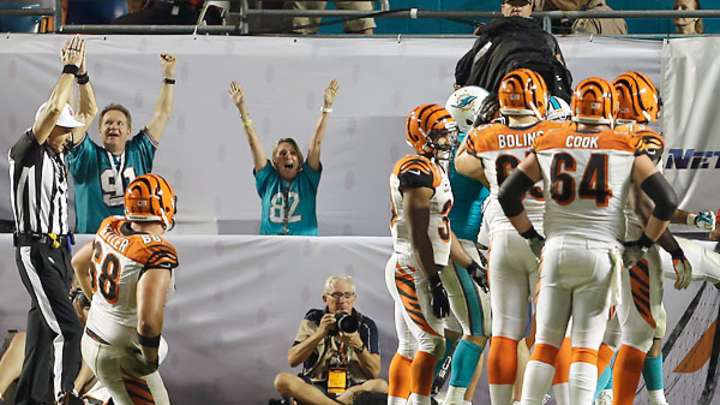Did refs get controversial safety call right in Dolphins-Bengals game? Replay says yes

Bengals fans may not like it, but Bill Leavy correctly ruled a safety to give the Dolphins the win. (Lynne Sladky/AP)

The NFL vice president of officiating said officials ruled correctly on Andy Dalton's game-ending safety Thursday night. The Cincinnati Bengals were not so sure.
Miami's Cameron Wake dropped Dalton in his own end zone a little more than nine minutes into overtime -- just the third time in NFL history that a game has ended on a safety. Referee Bill Leavy immediately made the safety signal as Dalton hit the ground, and he then confirmed that call on a replay review.
Appearing on the NFL Network's postgame show, vice president of officiating Dean Blandino backed Leavy's decision.
"The key is the position of the ball in relation to the goal line when Dalton is first contacted by Wake," the NFL's officiating guru said. "We had a great look at it, a look right down the goal line. And when Wake first makes contact with Dalton, the ball is breaking the plane of the goal line. If any part of that ball is breaking the plane when the contact occurs ... it's a safety. The entire ball has to be out of the end zone when contact occurs for it not to be a safety."
BURKE: Rare walk-off safety propels Dolphins to overtime victory over Bengals
There's no question that Dalton dropped into the Cincinnati end zone -- his entire body and the ball crossed the goal line before he stepped up to throw. However, the controversy (at least in the Bengals' eyes) arose because Dalton then crossed back over the goal line prior to being hit by Wake. The safety call stood because Dalton tucked the football as Wake tackled him, apparently pulling it back just enough to leave it in contact with the goal line.
Here's a shot of the moment Wake hit Dalton, and the football looks to be (just barely) touching the goal line:

That Dalton's heel and shoulder still were on the goal line is irrelevant. All that matters is the position of the ball, just as only the tip of the football needs to touch the goal line for a touchdown to be called.
Rule 3, Section 29 of the NFL rule book directly addresses this:
A Safety is the situation in which the ball is dead on or behind a team’s own goal line provided:
(a) the impetus (3-15-3) came from a player of that team;
(b) it is not a touchdown (11-2).
The important phrase there being "on or behind a team's own goal line." Leavy, and later Blandino, determined Dalton had brought the ball back across the invisible plane of the goal line of his own accord before being driven fully into the end zone by Wake.
Bengals coach Marvin Lewis, at least at the time of the postgame press conference, did not see it that way.
"In my opinion ... the ball was out of the end zone," Lewis said. "I don’t know. That’s a quick look at the board. They got a little better-resolution look than I did."
Dalton agreed with Lewis, though he admitted to not being fully clear on what was required of him to avoid the safety in that circumstance.
"It was tough. I don’t know exactly the rule, if it’s a foot, or if it’s the ball, or what it is, but from the replay I thought it was out," Cincinnati's QB said. "I don’t know. I’m not an official and I don’t know how they judge that."
This was about as close as this particular call can get. Had Dalton been about a millimeter farther back into the field of play, the result may have been different.
That Leavy announced the call as "confirmed" following a review means he had enough clear video evidence to back his initial ruling. ("The call stands" is the phrasing used when there is merely not enough conclusive evidence to overturn the ruling made on the field.)
It looks as if Leavy got it right -- and Blandino's backing supports that. Bengals fans, though, may have a different opinion on the matter.
BURKE: Bengals' Geno Atkins suffers knee injury against Dolphins
